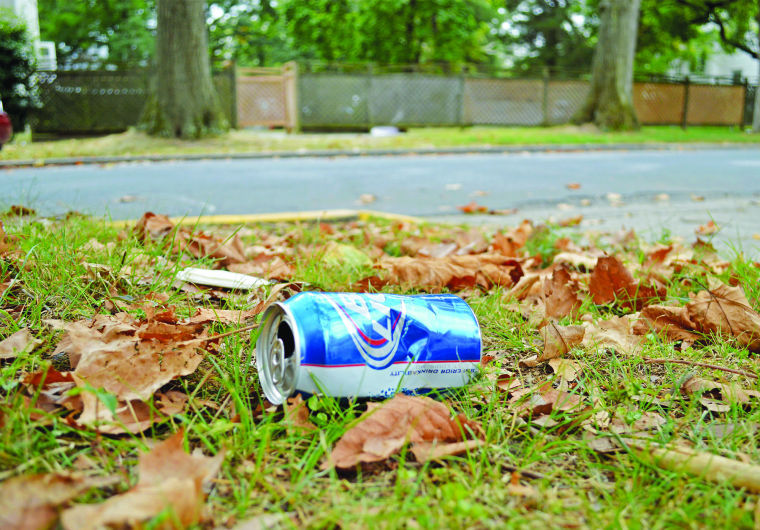
Trash on College Avenue
Last week, 90-year-old Amelia Murdoch heard students outside her house on Hartwick Road.
She opened her door to a group of young college men: her new neighbors. But they weren’t there to tear down parts of her fence. They weren’t milling about on the corner, yelling and leaving trash.
They were there to ask her to a party — and Murdoch couldn’t say no to a barbecue.
“That was a good hamburger,” said the College Park resident of 55 years.
“We thought that ourselves had been remiss in not extending the hand of friendship similarly in the past,” she added.
As College Park becomes increasingly squeezed with student renters, the friendly interaction was a small step forward in developing better relations between long-term city residents and their young neighbors. After the university’s recent expansion of the Code of Student Conduct and the city council’s development of a Neighborhood Stabilization and Quality of Life Workgroup to explore noise, traffic and trash concerns, among others, several long-term residents said they could see a positive difference.
But all that could soon change, residents said, with a slew of large-scale proposed development projects that could potentially bring thousands more students to flood the already packed city. With more students, the problems they’ve seen in recent years with partying,
vandalism, bottleneck traffic and more may worsen, residents said.
On Sunday afternoon, Bill Coleman — known as “Barbecue Bill” to his customers at the College Park Farmers Market — walked through the leafy, shade-speckled streets of Old Town College Park.
“There’s my house,” he said, pointing. “This is where people walk their dogs.”
He pointed out beer cans and broken bottles, planks missing from fences, rearview mirrors broken off cars, trash strewn around yards. A swivel chair lay on its side in someone’s front lawn, its ripped-off back about six feet away.
One night, he said, he saw someone who appeared to be “trying to have sex with [his] wife’s Volkswagen.” Another night, he awoke at 4 a.m. to a group of his neighbors throwing around giant plastic water containers.
The question he repeated over and over was, “Why?”
The issue is the sheer number of students, said Kathy Bryant, president of the Old Town Civic Association. The Maryland Book Exchange redevelopment, a proposed student housing complex which could add up to 855 beds to Old Town, is scheduled to break ground this fall, according to the July College Park Development Guide. The large structure doesn’t fit the historical nature of the neighborhood, Bryant said, adding it would serve as an “ugly” distraction looming over the entrance to the university.
“It is with dread that we await the coming of the Maryland Book Exchange [development],” Murdoch said.
Residents are more positive about the proposed redevelopment of the Knox Box apartments, which would include 1,550 beds in apartments and town homes, along with new retail establishments, a pool and a central green. Bryant hopes this development, which would be located on Knox Road and Guilford Drive, would draw some students away from Old Town and help bring new, diverse options into the city, such as nicer restaurants and a grocery store.
The recent opening of the Domain at College Park on Campus Drive brings to the city the first apartment complex not targeted at undergraduate students in more than a decade. Some residents said the complex could attract more faculty and staff to live in College Park.
Patrick Wojahn, a District 1 city councilman, said some of the developments would help revitalize the downtown.
More positive overall about the developments, Wojahn also sees relations improving between residents and students. Over the past year, Wojahn — who helps lead the council’s Quality of Life Workgroup — met with other council members, university officials, students, police and other stakeholders to discuss these issues.
The work group recently published a report presenting 63 recommendations which include some initiatives already implemented, such as the Code of Student Conduct expansion and “knock and talks,”- where officials have conversations with new residents about safety and rule enforcement.
To Wojahn, students’ behavior in the neighborhood has improved. Longtime city resident Pedro Guevara, of 4800 Calvert Rd., agreed.
“I can see the difference,” Guevara said. “This year there are parties in the daytime rather than the nighttime.”
As Coleman walked the city streets pointing out the damage, he also said he thought the situation was improving.
“Today there’s just a couple of mirrors [down],” he said, pointing.
“So far, it’s been relatively quiet,” he said. “Most kids on my street have come out and introduced themselves.”
In front of Murdoch’s house, two broken fence posts on Sunday morning may have been the work of students the weekend before. But she is hopeful for the future.
“About 10 years ago, a young man happened to be on the sidewalk, and we spoke. He said, ‘If you didn’t like [students], why’d you move here?’ And I said, ‘I was the one who was here,’” she said. “The season has just begun. We’ve had one pleasant interchange, but I’d like to see more of that. There might be a hard heart to soften.”



